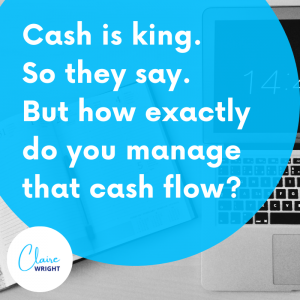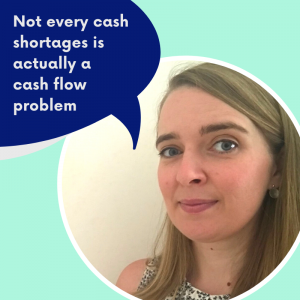There is always a lot of talk about managing your cash flow when it comes to business finances, though I’d say it applies equally to personal finances. Cash is king. Cash is the lifeblood of business etc.
So let’s look at what cash flow means, how it may show up in your business and how you can start managing it.
What is the problem of cash flow?
Cash flow is the movement of money through your business, clients send money to you as income and you send money to suppliers as expenses, to staff as salary and superannuation and to the tax department for various taxes including GST and income tax, these are all outgoings.
Managing your cash flow is ensuring there is enough money available to pay those expenses, salaries and taxes. This is especially important in businesses where income is produced AFTER expenses are incurred. Maybe you need to buy supplies to create products or you need to do work that is billed and then paid 30 days later.
No one wants to be in a situation where their business doesn’t have enough funds to cover its needs, which is where managing your cash flow comes in.
Signs you aren’t managing your cash flow
The major sign that you aren’t doing a great job of managing cash flow is that there never seems to be enough money in your business bank account to pay the outgoings.
For many sole traders and solo business owners, this shows up as the owner regularly needing to transfer money INTO the business bank account from their personal account.
However, it isn’t always that straightforward. This pattern could actually indicate a few different issues.
The personal problem
For example, let’s imagine $1000 comes in from a client. The owner withdraws 100% of that for personal use. Then a week later the owner needs to put $350 back to pay certain outgoings. In this scenario, the issue isn’t necessarily the business’s cash flow. But the owner almost disregarding the businesses needs. I’d suggest the cash flow issue could actually be at a personal level if the owner needs to withdraw everything that came in.
So we need to check the balance of money coming into the business from the owner AND money going out of the business to the owner.
The profit problem
If almost all of the cash that comes into the business bank account from clients and customers is being used purely for business. And the owner is still regularly transferring money in this suggests the business isn’t generating enough income to cover the outgoings.
For example, that $6000 came in during the month. The owner doesn’t withdraw any for personal drawings, salary, or use any for personal reasons. At the end of the month still needs to put in $500 to cover the last expenses. That is a profit problem. All the income is being spent on the business.
The cash flow problem
This is when at times the business has more cash than it needs but then at other times there isn’t enough to cover outgoings. This shows the timing difference between money coming and going out. This is why all businesses need start-up capital. Money to balance this timing difference. This can be captured as accounts receivable, work invoiced but not paid and work in progress, work completed but not yet invoiced.
For example, the business sends an invoice for $1000 to a client in May for work completed. The invoice won’t be paid until the end of June. Between now and then the business needs to pay its annual software subscription and doesn’t have the cash available.
How to start managing your cash flow
There are a few aspects it is important to understand. A lot of this will be estimated, but you can update it regularly as numbers are confirmed.
Who & What
This shows how cash is generated and utilised. List out the different places money comes into your business and estimate how much that is likely to be. Then list the different place money leaves your business and estimate how much.
When
This is the ‘flow’ part of cash flow. From the list of incomings and outgoings, you need to estimate when that transaction will occur. Make sure you cover off regular outgoings as well as more ad-hoc outgoings and annual outgoings. Is it always on the 15th of the month? On the 30th of June once a year etc.
Your Balance
Next, you need to put a figure on what funds are already available in your business. If there is $124 in your business account that is where you start. You’ll add to that as money comes in and take away from that as money goes out.
You need to then map those aspects together into a plan or timeline. Matching up the who/what with when. You should start to see a pattern and it will highlight when your funds might be too low to pay the outgoings.
Need help?
If you need more help get in touch to talk about making your business finances quicker, easier and actually work for your business.
Watch the Video
Pin for Later


